Episode 12
How to Plan for Success
With Mohit Aron, CEO & Founder of Cohesity
By Ashu Garg
07.10.2019
Two-time founder Mohit Aron tells me how blueprints and checklists can guide your startup in its earliest stages.
I. Episode Recap
Mohit Aron followed the siren song of entrepreneurship in 2009. He co-founded Nutanix, now worth billions, then founded and is CEO of second-storage company Cohesity, which has a billion-dollar valuation. So yeah, this is a guy who knows how to get a startup off the ground. Mohit gives me his blueprint and checklists for startup success and leadership hires. If your company is in the very early stages, you’ll want to listen to this one.
The Foundation is Everything
Building a company is like building a structure. There has to be a solid and stable foundation in place before you build the rest or else the whole thing crumbles.
The Blueprint (figure this out before your company is formed):
- Entry point: a product that solves customers’ pain and that they will pay for.
- Must have a total addressable market (TAM) of at least $5 billion.
- TAM is measured correctly; not over-exaggerated.
- Addresses customers’ known needs and pains, not their wants or what you think their pains are.
- There aren’t several similar companies that have already failed.
- Will reach $100 million revenue within 5 to 7 years, and is priced high enough that you don’t need a massive customer base to achieve that.
- Build in pivot points if no one’s buying the entry point.
- Something that competitors can’t copy too quickly.
- Industry trends are with you.
- Insertion point: product must be easy and desirable to use.
- Must have a total addressable market (TAM) of at least $5 billion.
- Bigger vision: what the company will be and produce beyond the entry point.
- Plan of execution: milestones and the time it will take to hit them.
The Technology Adoption Life Cycle and Product-Market Fit
- Early adopters: people you know or your VC knows, usually 10 to 15 percent of your initial market.
- They will give you feedback that helps you polish your product for the next set of customers.
- They will give you feedback that helps you polish your product for the next set of customers.
- Early majority: companies that don’t usually buy from startups but your entry point is so enticing that they buy it.
- Product-market fit: Mohit’s definition is an average sales person can sell your product to an average company without having to get headquarters involved. This means your company can scale.
- Don’t go for the early majority if your product isn’t ready; these customers won’t accept an unstable product the way early adopters will.
- How to find early majority customers: look for companies that have bought similar products and/or bought from other startups.
- Only go for the customers that you know need what you are selling.
- Product-market fit: Mohit’s definition is an average sales person can sell your product to an average company without having to get headquarters involved. This means your company can scale.
Checklist your Way to Good Non-Technical Hires
As a technical founder, Mohit thought non-technical and technical hires were the same. They are not. Now, he has a three-phase checklist that potential hires must meet to be considered.
- Phase 1: Pre-interview
- Look for a good job history, relevant experience, and results in previous companies.
- Look for a good job history, relevant experience, and results in previous companies.
- Phase 2: The interview
- Look for a good culture/chemistry match — but don’t hire solely based on chemistry.
- Look for red flags
- Look for a good culture/chemistry match — but don’t hire solely based on chemistry.
- Phase 3: Post-interview
- Check the references the candidate gives you. These will usually validate the positives you saw in the candidate but they won’t tell you the negatives.
- Find blind references. Seek out peers and direct reports. They will tell you what the negatives or red flags might be.
- Check the references the candidate gives you. These will usually validate the positives you saw in the candidate but they won’t tell you the negatives.
A Bigger Hiring Pipeline is Worth the Money
Recruiting is expensive, but hiring the wrong person costs even more. Don’t cut corners.
- Be careful not to hire a big name too soon; they will be bored with a small company and an unpolished product.
Published on 07.10.2019
Written by Ashu Garg


